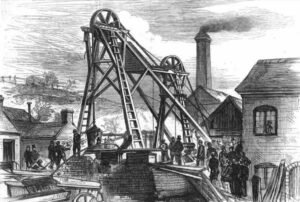BUNKERS HILL. Audley, Staffordshire. 30th. April, 1875.
The colliery was the property of Messrs. William Rigby and Company, with Mr. George Sumner as the manager. An explosion took place at the colliery, which claimed the lives of forty men and boys. The colliery was close to the Talk o’ th’ Hill and Bignall Hall Collieries at which there had been previous disasters. Every precaution was taken for the safety of the men, and on the morning of the disaster, one hundred went to work in the pit, including thirty-five into the Eight Feet Banbury seam to work about 800 yards from the shaft.
The explosion occurred about 1 p.m., causing some damage to the headgear. Exploring parties went down the pit, and a few bodies were found, including that of Nehamiah Sumner, the manager’s son but the majority of the men were working at the far end of the workings, which were not reached until late at night. By 5 p.m. forty-one bodies had been recovered, and it was thought that all were out of the pit but a poor woman enquired about her husband. A further search was organised, and his body was found at the far end of the dip. Two of the men had started work the previous day and had been down the pit for only two hours
Those who died:
- J. Ashmore
- C. Baddeley
- T. Beech
- D. Boston
- W. Boughey
- J. Boyd
- E. Breeze
- J. Buckley
- G. Burton
- J. Carter
- J. Chadwick
- D. Charlesworth
- I. Cooper
- R. Dale
- H .Dean
- T. Dean
- D. Fox
- E. Hancock
- J. Hancock
- W. Hancock
- J. Higgins
- G. Holland
- J. Holland
- T. Holland
- R. Jackson
- T. Lawton
- J. Lucas
- J. Marshall
- T. Mason
- W. Maxwell
- H. Moore
- W. Moore
- S. Morris
- J. Nield
- T. Peats
- W. Proudlove
- J. Rogers
- J. Stevenson
- J. Stubbs
- N. Sumner
- T. Thompson
- J. Yearsley
- One unnamed.
The inquest into the disaster was opened at the Swan Inn, Talk o’ th’ Hill, by Mr. J. Booth, Coroner. Mr. Wynne, the Inspector, made a thorough inspection of the workings and Mr. S.B. Gilroy, Assistant Inspector, thought the mine was well managed but Mr. Wynne commented
For more than twenty years I have been pointing out what a “farce” it is to prohibit the use of naked lights in mines and yet allow powder to be used and have indulged in the hope that self-preservation would prevail over the more idle method of getting coal by blasting but I am now satisfied that the only safe course to take, is to prohibit all explosives in coal mines, and in a few years the coal owners would wonder how they could have allowed their coals to be blow to atoms and the roofs shaken as they have been for many years and the colliers would find that, having got rid of the impure fumes of the powder and dangers of explosions, together with the comparative safety from falls of roof, they were amply repaid for an extra hour of labour the wedging process would entail. Nothing could more clearly show the advantage of wedging over those of powder than to state of the two downbrows of 600 yards each, which effectually withstood the enormous strain which must have been put on them by the force of the air that must have been driven from the seat of the explosion, to the top of the upcast shaft, not so much as a hundredweight of coal was blown down in them or in the dips the slightest degree injured, or indeed was that proportion of the levels which was driven without blasting.
The only reason assigned for the change from wedging to blasting was, that Mr. Rigby could not compete with his neighbours if he wedged the coal and they blasted theirs so that to meet competition, he was obliged to increase production and lessen cost.
In the report made by Mr. Dowdswell, there was no doubt that the explosion was caused by a shot fired in a thirling on the East side of the engine brow, and he was satisfied that there had been no breach of the rules and the fireman had taken all precautions before he fired the shot. It was thought that the method for firing the shots by a touch paper was the most dangerous. It was thought that the fireman went to light the fuse and retired to a place which he thought was safe and opened his lamp to light the touch paper and it was thought that the gas came from the floor of the mine.
The jury returned and open verdict and recommended that blasting should be discontinued in all mines in which safety lamps were used. They also recommended that in opening out new workings, the ventilation should be set by bratticing and not by air pipes.
REFERENCES
Mines Inspector Report 1875. Mr. Thomas Wynne.
Colliery Guardian, 7th May, p.674, 14th May, p.702.
Information supplied by Ian Winstanley and the Coal Mining History Resource Centre.
Return to previous page


